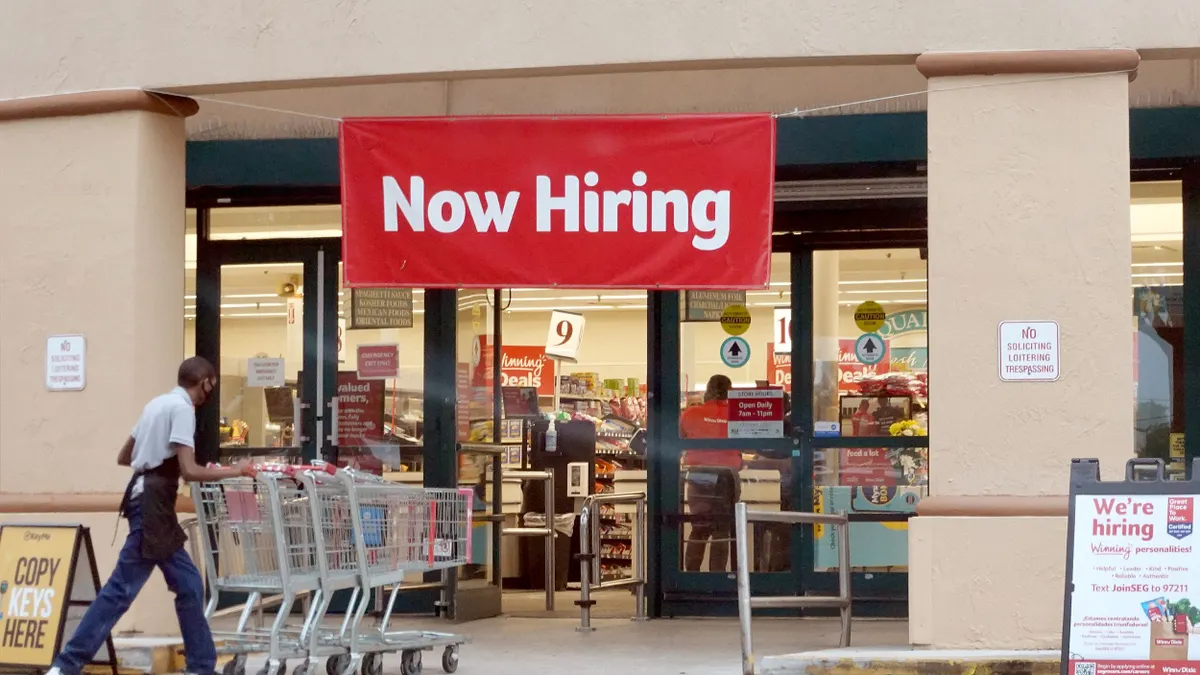Richard Larson had to confront himself. He spoke of a moment when he literally looked into the mirror — "that's it," he thought. It was time to read what he wrote.
In 2012, Larson, then a tenured professor at the Massachusetts Institute of Technology (MIT), had co-authored a paper on the effect of the elimination of mandatory retirement age policies on the amount of slots available to new faculty members at the university. It found that the annual inflow of openings for new professors had been reduced by 19%.
It was after the paper's publication that Larson, now Mitsui Professor of Data, Systems and Society at MIT in a post-tenure role, began to wonder what the implications were for the careers of his colleagues, he told HR Dive in an interview. A self-described MIT lifer, Larson thought about one of his postdocs, who worried that he wouldn't be able to obtain the tenure-track position he sought.
"Every day, every month, every year that I spend as a tenured, chaired faculty member is a year that a young person can not start such a career at MIT," Larson said. "I felt selfish."
Larson isn't the first to consider the impact of eliminating mandatory retirement policies. At a time when older generations of U.S. workers are working statistically longer than previous generations did, the question is whether younger workers are losing out.
The end of mandatory retirement
The 1980 to 2010 time period of Larson's study encompassed significant events in the life of the federal Age Discrimination in Employment Act of 1967 (ADEA). When it became law, the ADEA made it illegal for employers to discriminate against individuals in certain employment contexts on the basis of their age.
Congress amended the law several times to explicitly prohibit seniority systems or benefits plans from requiring or permitting involuntary retirement at a certain age, including in 1986, when it extended this protection to virtually all workers. The amendments act made exemptions for certain occupations affecting public safety, like firefighters, as well as employees who had a contract of unlimited tenure, like university faculty.
Prior to 1982, organizations employing tenured faculty could require involuntary retirement at age 65, per the ADEA. In 1982, this age limit was raised to 70 thanks to Congressional amendments, before the 1986 amendments act allowed the provision for tenured faculty to expire at the end of 1993 altogether.
Today, mandatory retirement policies are permitted only for a select few cases under the ADEA. Employers must establish that age is "bona fide occupational qualification" under the terms of the law. Employers may also establish mandatory retirement policies for certain "bona fide executives" and "high policymakers" who reach age 65.
But these cases are few and far between, Cathleen Snyder, director, HR and development at strategic HR Inc., told HR Dive in an interview. "In general, we aren't seeing much of that anymore," she said of policies affecting such executives and policymakers.
Pressure on younger workers?
Against this backdrop, employers have reported cases in which employees working past traditional retirement age have affected their ability to operate.
In a 2017 white paper, Mercer senior partner Haig Nalbantian described a situation faced by one of the consultancy's clients (dubbed "ConsumerCo"). The global consumer product company felt "the unintended consequences of losing control over the retirement decision of employees," Nalbantian wrote, and the increase in its average retirement age "substantially reduced" the rate at which middle and upper career level positions opened.
The end effect for ConsumerCo was the creation of "career choke points" at lower levels of the company's workforce, which had the effect of blocking opportunities for advancement, according to the white paper. That said, Nalbantian didn't explicitly cite the ADEA as a source of ConsumerCo's struggles.
Instead he pointed to the company's decision to switch from a defined benefit retirement plan to a defined contribution plan with a profit-sharing component. When an economic downturn hit, employees' defined contribution account balances declined, making the situation uncertain for retirement-eligible workers, many of whom decided to hold onto their jobs.
Situations like ConsumerCo's do exist, but others dispute the general argument that extended retirement leads to a bottleneck for younger employees. Chris Farrell, author and senior economics contributor at Marketplace, told HR Dive that in the broader context of the U.S. economy, fears of a bottleneck aren't well substantiated. "There's no evidence this is true for the whole economy," he said.
An important counter-example, Farrell added, is the women's movement during the 20th century. At the time, op-eds and commentary suggested that the addition of women to payrolls would mean a reduction in available jobs for men, but the trend actually contributed to significant growth, he explained. "It's understandable that people would think that," Farrell said of the bottleneck argument, which might seem reasonable for those in certain industries undergoing economic fluctuations, "but they're wrong."
Getting phased retirement right
Companies could opt to smooth the transition for those preparing for retirement by introducing some sort of phased retirement benefit, but few have such programs, Farrell said. The Society for Human Resource Management's 2019 Employee Benefits Survey found that just 15% of employers had an informal phased retirement program, while 6% had a formal one.
There are challenges to creating and sustaining these types of programs, experts previously told HR Dive. Difficulties with administration, medical costs and compliance, among others, are considerations employers might have.
"It's the shift of a mindset of retirement to a mindset of retainment."
Chris Farrell
Author and senior economics contributor, Marketplace
But done right, the programs can be effective, Snyder said. Companies are cognizant of the fact that older generations take their talent and knowledge with them when they leave, she noted, so many are leaving these workers the option to scale back hours.
One of strategic HR's clients wanted to bring a former lead machinist — an employee in a hard-to-replace, highly-skilled role — back as a 1099 employee. This method is "hard to do," Snyder explained, so the company scaled back the employee's hours, and he returned on a part-time basis.
"You need to realize you're setting a precedent," Snyder said of phased retirement programs. "You need to be careful in how you're structuring that policy."
Larson, for his part, has enjoyed the post-tenure arrangement he made with MIT, and he wrote about the experience in an article for Science magazine. The arrangement allowed him to pursue what he wanted in his career after he realized he didn't need tenure for those objectives.
MIT's HR staff reached out to Larson after reading the Science article, he said, and they asked if he might be interested in being referred to other senior faculty members considering a post-tenure arrangement so that he could share his experience. So far, he's up to six such clients. The conversations Larson has are confidential, and he said he's had "very great interest" from faculty members.
"It's not about finances," he said of the conversations. "It's more … the psychology of this, how you approach it."
Larson's advice to organizations thinking about a phased retirement policy is to make sure that employees are aware of it, and to make the program "friendly and flexible" so that those with different needs or conditions are able to negotiate them.
Regardless of the approach a company takes, it may want to have a set policy in place anyway, Farrell said, because management has an incentive to keep older workers around: "It's the shift of a mindset of retirement to a mindset of retainment."





















